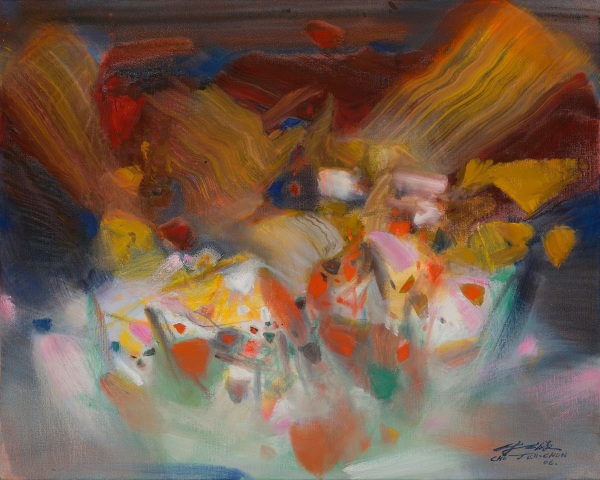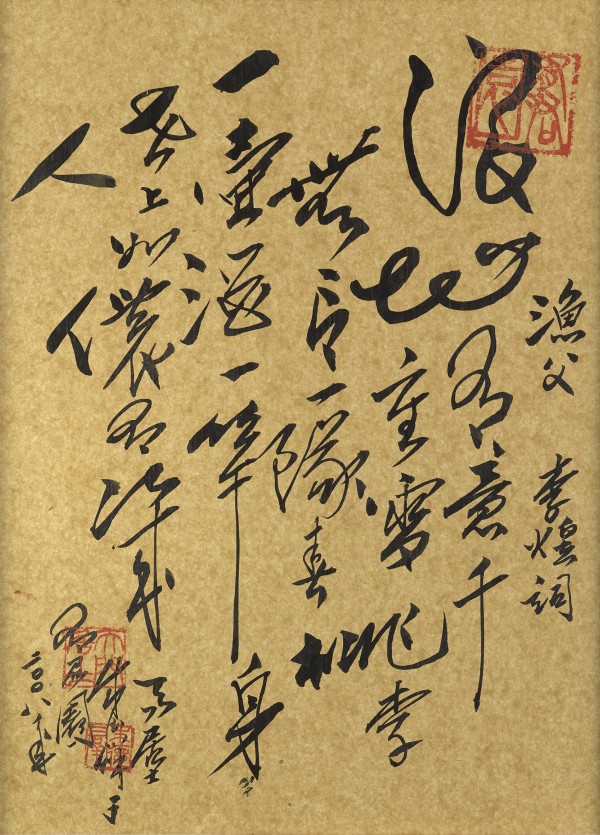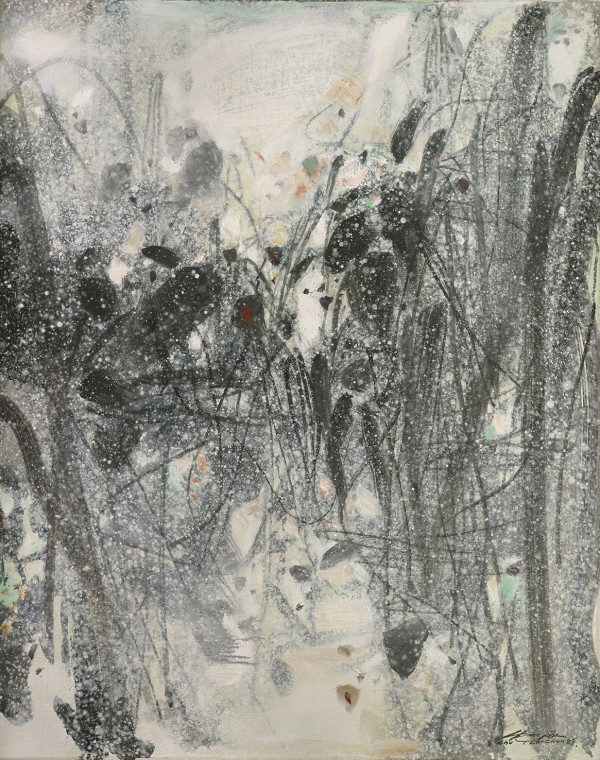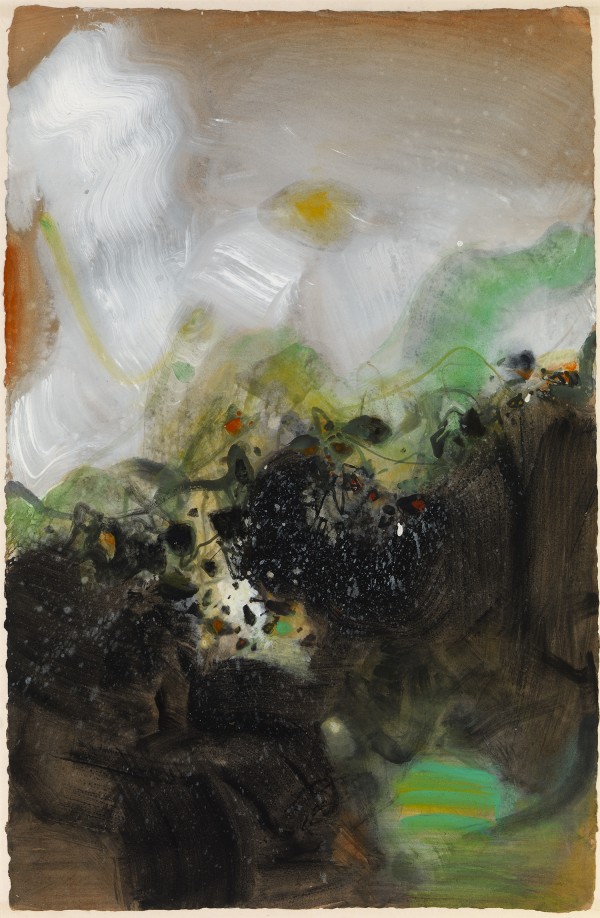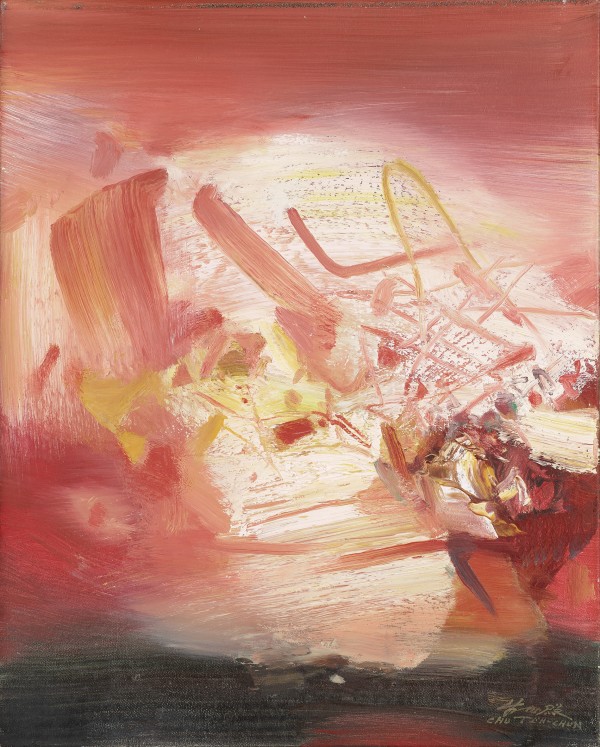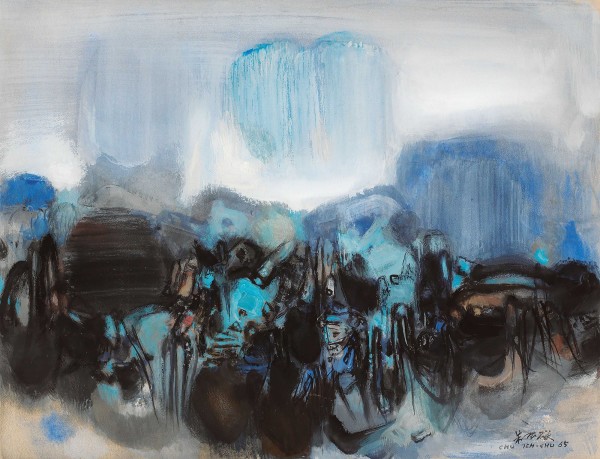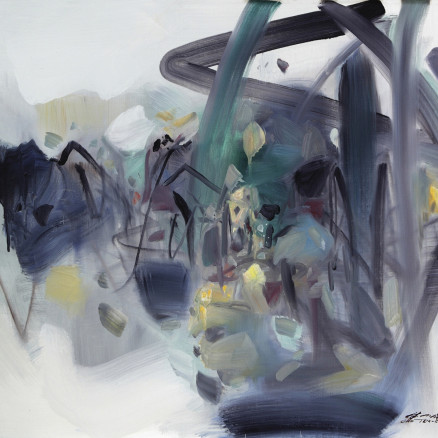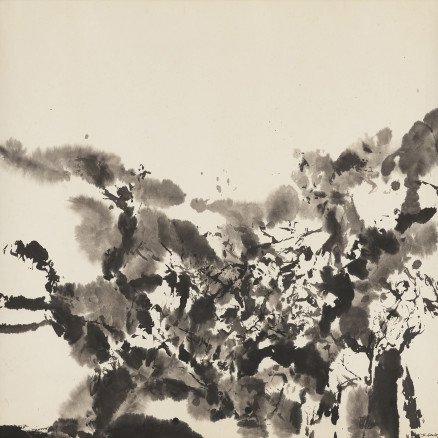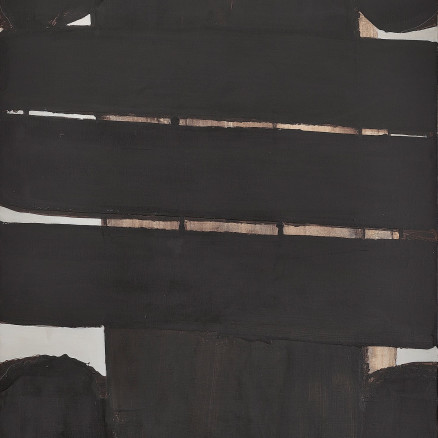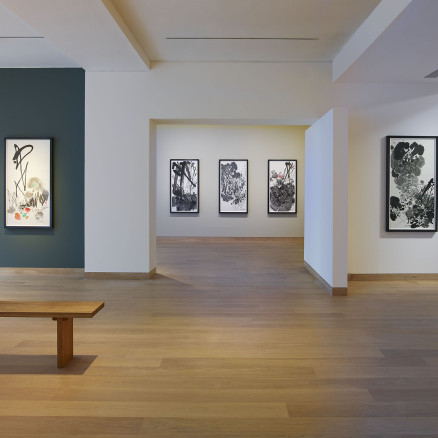Biography
Chu Teh-Chun (b.1920, Baitu, Jiangsu, China; d.2014, Paris, France) is renowned for his abstract oil paintings of imagined and dramatic landscapes. Although painted from the confines of his studio, Chu’s landscapes are inspired by his extensive travels and have a profound sense of depth, poetry and musicality.
Born into a wealthy family, Chu began to learn calligraphy aged five, while also acquiring a fundamental knowledge of Tang dynasty poetry. As a result of his family’s art collection, he discovered and studied the works of Wang Xizhi and, in 1935, went on to study European Watercolour and Oil Painting under Wu Dayu at the National Academy of Fine Arts, Hangzhou. His lessons with modern ink master Pan Tianshou enabled Chu to become familiar with the freedom and innovation of the Qing individualists, in particular Bada Shanren’s subjective and revolutionary approach to space and Shitao’s emphasis on the calligraphic line. During his time at the Academy, he became friends with fellow student Zao Wou-ki and later persuaded Wu Guanzhong to give up engineering for painting, who is now recognised as a founder of modern Chinese painting. The outbreak of the Sino-Japanese War in 1937 forced the Academy into itinerancy, allowing Chu to see the dramatic landscapes of southern China. After teaching drawing at the National Central University in Nanjing and Fine Art at the National Taiwan Normal University in Taipei inTaiwan, Chu moved to Paris in 1955.
After settling in Paris, Chu began to adopt the figurative realism that he saw in the Paris Salon, earning him the Silver Medal in 1956. That same year, after a visit to a Nicolas de Staël retrospective at the Musée National d’Art Moderne, Chu began to pursue abstraction. Staël had a lasting impression on Chu, his works inspiring the iconic visual language that Chu aimed to refine for the rest of his life. The contemporary European enthusiasm for avant-garde non-figurative abstraction and action painting encouraged Chu to rediscover ‘abstract’ elements within his own painting tradition. Since the Tang dynasty, Chinese literati painting had abstracted from nature and regarded painting, calligraphy and poetry as interwoven threads of the same fabric. Although Chu adopted the traditional European medium of oil painting, he regarded his approach as inherently Chinese. He resumed his study of calligraphy in the late 1960s, imbuing his spontaneous compositions with an increasingly practised hand, and instilling his works with the wisdom of ancient classical texts, such as the Book of Changes. The sweeping brushstrokes of Chu’s ink, gouache and oil works explore the inseparable relationship between painting and calligraphy and carry the weight of the mythical origins of Chinese writing.
Chu resided in Paris for the remainder of his life, eventually adopting French citizenship in 1980. In 1997, he became the first Chinese member of the Académie des Beaux-Arts, Paris and was awarded the Chevalier de l’Ordre des Palmes Académiques and the Chevalier de la Légion d’Honneur in 2001. The Fondation CHU Teh-Chun was founded in Geneva in 2017 by the artist’s family and in 2020, to mark the 100th anniversary of his birth, they collaborated on a new documentary film about Chu’s personal and artistic journey from a turmoil-ridden China to his professional rise and recognition in France.
Chu Teh-Chun, who rapidly gained international recognition, has been the subject of several important retrospectives. Some notable ones include: André Malraux Museum, Le Havre (1982); Shanghai Museum of Art (2000); National Museum of History of Taipei, Taiwan (2008); National Art Museum of China, Beijing (2010); and Fondation Monticelli, Marseille (2015). The retrospective In Nebula, curated by Matthieu Poirier, took place at the Fondazione Giorgio Cini in Venice from 20 April to 30 June 2024, on the occasion of the 60th edition of the Venice Biennale of International Art. His work is also represented in public collections, including the Bibliothéque Nationale, Paris; Guangdong Museum of Art, Guangzhou, China; Musée des beaux-arts André Malraux, Le Havre; Musée d’art moderne de la Ville de Paris; Musée Cernuschi, Paris; National Museum of History, Taipei; Shanghai Museum of Art, Shanghai; and Taipei Fine Art Museum, Taiwan.
Works
-
 Chu Teh-Chun, Eclosion tenace, 2006
oil on canvas
25 5/8 x 31 7/8 in
65 x 81 cm
%3Cdiv%20class%3D%22artist%22%3E%3Cspan%20class%3D%22artist%22%3E%3Cstrong%3EChu%20Teh-Chun%3C/strong%3E%3C/span%3E%3C/div%3E%0D%3Cdiv%20class%3D%22title%22%3E%3Cem%3EEclosion%20tenace%3C/em%3E%2C%202006%3C/div%3E%0D%3Cdiv%20class%3D%22medium%22%3Eoil%20on%20canvas%3C/div%3E%0D%3Cdiv%20class%3D%22dimensions%22%3E25%205/8%20x%2031%207/8%20in%3Cbr%20/%3E%0A65%20x%2081%20cm%3C/div%3E
Chu Teh-Chun, Eclosion tenace, 2006
oil on canvas
25 5/8 x 31 7/8 in
65 x 81 cm
%3Cdiv%20class%3D%22artist%22%3E%3Cspan%20class%3D%22artist%22%3E%3Cstrong%3EChu%20Teh-Chun%3C/strong%3E%3C/span%3E%3C/div%3E%0D%3Cdiv%20class%3D%22title%22%3E%3Cem%3EEclosion%20tenace%3C/em%3E%2C%202006%3C/div%3E%0D%3Cdiv%20class%3D%22medium%22%3Eoil%20on%20canvas%3C/div%3E%0D%3Cdiv%20class%3D%22dimensions%22%3E25%205/8%20x%2031%207/8%20in%3Cbr%20/%3E%0A65%20x%2081%20cm%3C/div%3E -
 Chu Teh-Chun, Untitled, 2008
China ink on Kraft paper
42.5 x 31 cm
%3Cdiv%20class%3D%22artist%22%3E%3Cspan%20class%3D%22artist%22%3E%3Cstrong%3EChu%20Teh-Chun%3C/strong%3E%3C/span%3E%3C/div%3E%0D%3Cdiv%20class%3D%22title%22%3E%3Cem%3EUntitled%3C/em%3E%2C%202008%3C/div%3E%0D%3Cdiv%20class%3D%22medium%22%3EChina%20ink%20on%20Kraft%20paper%3C/div%3E%0D%3Cdiv%20class%3D%22dimensions%22%3E42.5%20x%2031%20cm%3C/div%3E
Chu Teh-Chun, Untitled, 2008
China ink on Kraft paper
42.5 x 31 cm
%3Cdiv%20class%3D%22artist%22%3E%3Cspan%20class%3D%22artist%22%3E%3Cstrong%3EChu%20Teh-Chun%3C/strong%3E%3C/span%3E%3C/div%3E%0D%3Cdiv%20class%3D%22title%22%3E%3Cem%3EUntitled%3C/em%3E%2C%202008%3C/div%3E%0D%3Cdiv%20class%3D%22medium%22%3EChina%20ink%20on%20Kraft%20paper%3C/div%3E%0D%3Cdiv%20class%3D%22dimensions%22%3E42.5%20x%2031%20cm%3C/div%3E -
 Chu Teh-Chun, Evocations B, 1989
oil on canvas
92 x 73 cm
Chu Teh-Chun, Evocations B, 1989
oil on canvas
92 x 73 cm
-
 Chu Teh-Chun, Ciel coloré, 1985
gouache on paper
73.5 x 48 cm
%3Cdiv%20class%3D%22artist%22%3E%3Cspan%20class%3D%22artist%22%3E%3Cstrong%3EChu%20Teh-Chun%3C%2Fstrong%3E%3C%2Fspan%3E%3C%2Fdiv%3E%0D%3Cdiv%20class%3D%22title%22%3E%3Cem%3ECiel%20color%C3%A9%3C%2Fem%3E%2C%201985%3C%2Fdiv%3E%0D%3Cdiv%20class%3D%22medium%22%3Egouache%20on%20paper%3C%2Fdiv%3E%0D%3Cdiv%20class%3D%22dimensions%22%3E73.5%20x%2048%20cm%3C%2Fdiv%3E
Chu Teh-Chun, Ciel coloré, 1985
gouache on paper
73.5 x 48 cm
%3Cdiv%20class%3D%22artist%22%3E%3Cspan%20class%3D%22artist%22%3E%3Cstrong%3EChu%20Teh-Chun%3C%2Fstrong%3E%3C%2Fspan%3E%3C%2Fdiv%3E%0D%3Cdiv%20class%3D%22title%22%3E%3Cem%3ECiel%20color%C3%A9%3C%2Fem%3E%2C%201985%3C%2Fdiv%3E%0D%3Cdiv%20class%3D%22medium%22%3Egouache%20on%20paper%3C%2Fdiv%3E%0D%3Cdiv%20class%3D%22dimensions%22%3E73.5%20x%2048%20cm%3C%2Fdiv%3E -
 Chu Teh-Chun, Fond Rouge, 1984
oil on canvas
41 x 33 cm
Chu Teh-Chun, Fond Rouge, 1984
oil on canvas
41 x 33 cm
-
 Chu Teh-Chun, Composition - 1965, 1965
gouache on paper laid down on canvas
19 1/4 x 25 1/4 in
48.8 x 64 cm
%3Cdiv%20class%3D%22artist%22%3E%3Cspan%20class%3D%22artist%22%3E%3Cstrong%3EChu%20Teh-Chun%3C/strong%3E%3C/span%3E%3C/div%3E%0D%3Cdiv%20class%3D%22title%22%3E%3Cem%3EComposition%20-%201965%3C/em%3E%2C%201965%3C/div%3E%0D%3Cdiv%20class%3D%22medium%22%3Egouache%20on%20paper%20laid%20down%20on%20canvas%3C/div%3E%0D%3Cdiv%20class%3D%22dimensions%22%3E19%201/4%20x%2025%201/4%20in%3Cbr%20/%3E%0A48.8%20x%2064%20cm%3C/div%3E
Chu Teh-Chun, Composition - 1965, 1965
gouache on paper laid down on canvas
19 1/4 x 25 1/4 in
48.8 x 64 cm
%3Cdiv%20class%3D%22artist%22%3E%3Cspan%20class%3D%22artist%22%3E%3Cstrong%3EChu%20Teh-Chun%3C/strong%3E%3C/span%3E%3C/div%3E%0D%3Cdiv%20class%3D%22title%22%3E%3Cem%3EComposition%20-%201965%3C/em%3E%2C%201965%3C/div%3E%0D%3Cdiv%20class%3D%22medium%22%3Egouache%20on%20paper%20laid%20down%20on%20canvas%3C/div%3E%0D%3Cdiv%20class%3D%22dimensions%22%3E19%201/4%20x%2025%201/4%20in%3Cbr%20/%3E%0A48.8%20x%2064%20cm%3C/div%3E
Waddington Custot Participates in Frieze Masters 2020
Frieze Masters 2020 Online Viewing Room
VIP Preview | 7–8 October 2020
Opening Dates | 9–16 October 2020
Jean Arp, Peter Blake, Enrico Castellani, Chu The-Chun, Jean Dubuffet,
Barry Flanagan, Peter Halley, Hans Hartung, Manolo Millares, Joan Miró, Robert Motherwell, Kenneth Noland, Pablo Picasso, Serge Poliakoff,
Jean-Paul Riopelle, Pierre Soulages, Bernar Venet and
Maria Helena Viera da Silva.
Waddington Custot participates in the inaugural edition of Frieze Masters Online Viewing Room.
A VIP Preview of the Waddington Custot Frieze Masters presentation takes place across Frieze from 7–8 October. Access to explore Frieze Masters Online Viewing Room is free and open to all from 9–16 October, preregister here.
Read more





